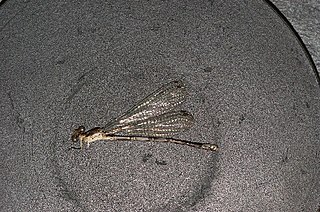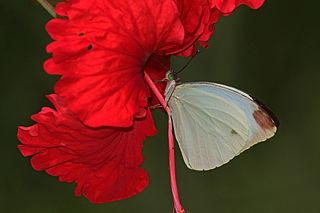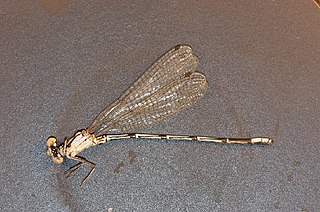
The amethyst dancer is a damselfly of the family Coenagrionidae, native from southwestern North America south to Guatemala.

The lavender dancer is a damselfly of the family Coenagrionidae, native to the western United States from west Texas to southern California, as well as adjacent regions of northern Mexico.

The variable dancer is a damselfly of the family Coenagrionidae. It is native to North America, where it is widespread throughout the east and present in the interior western United States.

Argia is a genus of damselflies of the family Coenagrionidae and of the subfamily Argiinae. It is a diverse genus which contains about 114 species and many more to be described. It is also the largest genus in Argiinae. They are found in the Western Hemisphere. They are commonly known as dancers. Although the genus name comes from Ancient Greek: ἀργία, romanized: argia, lit. 'laziness', dancers are quite active and alert damselflies. The bluer Argia species may be confused with Enallagma species.
Argia or Argea may refer to:

The Basque Wikipedia is the Basque language edition of Wikipedia. Founded on December 6, 2001, although its main page was created in November 2003, it reached 58,124 articles by August 19, 2010, making it the 45th-largest Wikipedia. As of September 2022, it has 261 active contributors, of which 12 are administrators, and has about 398,000 articles.
Amphipteryx agrioides, the montane relict damsel, is a species of damselfly in family Amphipterygidae. It is found in Guatemala, Honduras, Mexico, and possibly Colombia. Its natural habitats are subtropical or tropical moist montane forests and rivers. It is threatened by habitat loss through deforestation for coffee plantations and cattle ranching.
Amphipteryx is a genus of damselflies, the only genus in the family Amphipterygidae. It is limited to Mesoamerica from Mexico to Honduras and Guatemala.
Platycnemis agrioides is a species of damselfly in the family Platycnemididae. It is endemic to Mayotte. Its natural habitats are subtropical or tropical moist lowland forests and rivers. It is threatened by habitat loss.

Argia is a weekly news magazine published in the Basque language, the oldest one still in circulation. Their main office is in Lasarte-Oria, Basque Country. Its name was Zeruko Argia from 1919 to 1921 and from 1963 to 1980, and Argia from 1921 to 1936 and from 1980 to present. It had to cease its activity because of the Spanish Civil War in 1936, and it could not be published again until 1963, when Francoist Spain lifted its ban on Basque-language publications.

Nepheronia argia, the large vagrant, is a butterfly of the family Pieridae. It is found throughout Africa.

L'Argia is an opera in a prologue and three acts composed by Antonio Cesti to a libretto by Giovanni Filippo Apolloni. It was first performed in the court theatre at Innsbruck on 4 November 1655 to celebrate the visit of Queen Christina of Sweden who was on her way to exile in Rome. Over the next 20 years it had multiple performances in Italian cities including Venice and Siena where it inaugurated Siena's new opera house in 1669. Its first performance in modern times took place at the Innsbruck Festival of Early Music in 1996. Set on the Island of Cyprus in ancient times the opera's convoluted plot, full of disguises and mistaken identities, revolves around the amorous misadventures of Selino who has been pursued to Salamis by his deserted wife Princess Argia.

Argia sedula, the blue-ringed dancer, is a species of narrow-winged damselfly in the family Coenagrionidae. It is found in Central America and North America.

Argia leonorae, known generally as the Leonora's dancer or turnip, is a species of narrow-winged damselfly in the family Coenagrionidae. It is found in Central America and North America.

Argia barretti, the Comanche dancer, is a species of narrow-winged damselfly in the family Coenagrionidae. It is found in Central America and North America.

Argia tibialis, the blue-tipped dancer, is a species of narrow-winged damselfly in the family Coenagrionidae. It is found in Central America and North America.

Argia lugens, the sooty dancer, is a species of narrow-winged damselfly in the family Coenagrionidae. It is found in Central America and North America.

Argia rhoadsi, the golden-winged dancer, is a species of narrow-winged damselfly in the family Coenagrionidae. It is found in Central America and North America.














